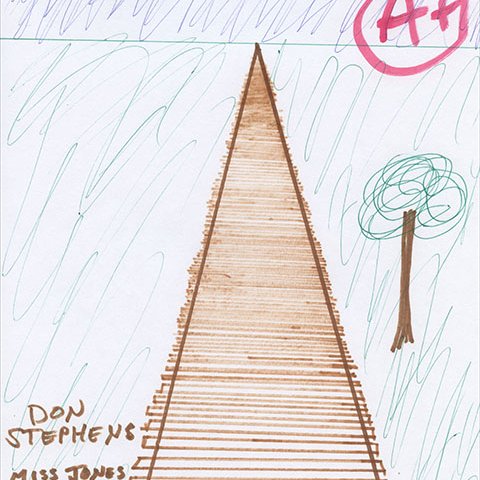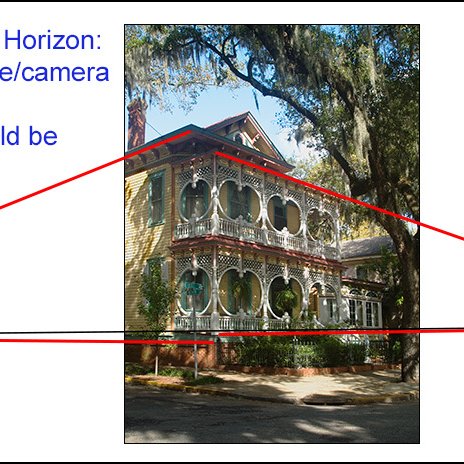Part 1: Understanding Perspective – Vanishing Points and Horizons
Vanishing Points
Think back to elementary school days. Did your primary teacher or art instructor teach you to do perspective drawing? Mine did. Simplest was “one-point” perspective, where railroad tracks were drawn to start as two rails at the bottom of your drawing, but converged into a single point, the VANISHING POINT, at the distant horizon toward the top of your page.

Railroad tracks with one-point perspective
A point of trivia: in the US, the standard gauge or distance between rails, is four feet, eight and a half inches. The rails are parallel, always 4’ 8.5” apart. By definition parallel lines never meet but they appear to meet at great distances, and that’s due to perspective. Near things seem large, and as things get farther away, they seem smaller. The point of view in the RR track example is looking slightly downward at the tracks which are depicted to be below you, maybe at your feet, and extending out to infinity. Your camera can also record one-point perspective.
Then, maybe a year later, came two-point perspective art lessons, where factually horizontal, level, and parallel lines on buildings, if viewed at an angle (e.g., not straight-on) appear to converge at vanishing points to the left and right.

Large house with two-point perspective
This convergence not only applies to regular rectilinear shapes like buildings, but to all three-dimensional subjects, like the human head and face. More on portraiture later. This is how your eyes and your camera lens see things.
Viewing or photographing 3-D subjects straight-on is a special case of one-point perspective, sometimes called “Zero-Perspective.” It’s often the least dynamic and interesting, and least informative point of view.

House with straight-on "zero" perspective
Horizons
Before going further, let’s define HORIZONS. Conceptually, the horizon is where the ground ends and the sky begins. Oversimplified, as in the railroad track sketch, it is a straight and level left-right line. But what if there are hills or mountains along the horizon, or trees or structures, or if you can only see one end of the horizon at a closer or greater distance than the other end? That would still be a horizon of sorts, but it’s not very useful to us, even as a concept. Let’s call that the VISUAL HORIZON. It’s probably neither straight nor level due to irregularities and perspective. For example, consider the zero-perspective view. Where is the visual horizon? And, how about water and other liquids? The surface of calm water is in fact level, and out at sea with no land visible, you can take the water’s visual horizon to be level. But if you’re viewing or depicting a lake or river, the visible near or far sides of the water probably do not and should not look level because of perspective. So, don’t jump to the conclusion that the image is not level because the near or far side of the lake is not level.
So, where is the horizon on which left and right vanishing points happen? I call this the OPTICAL HORIZON. I define this as an invisible, imaginary horizontal line. It exists in your mind’s eye, within and extending beyond your camera’s view, but may not coincide with any real line anywhere in your field of view or image. It is at your eye/camera height. Squat down and it becomes low, or from a ladder or airplane it is higher, maybe even above your subjects. Is it level? Ideally, but it won’t be in your photo if your camera is not level.
Where are the vanishing points on this optical horizon? That depends on your viewing angle and distance from the subject. At a close distance, perhaps when using a wide-angle lens, the vanishing points will be relatively close to the subject. Or, at greater distance, the vanishing points will be farther out on the optical horizon. Note that the vanishing points are often well outside of the field of view of your eyes or camera or printed image.

Illustration of two-point perspective and optical horizon
A photo taken too close-up may give an unpleasant or unrealistic looking, too-strong or exaggerated perspective. Too far away, perhaps using a tele-photo lens, and the perspective may be weak, giving a feeling that the subject is rather flat, perhaps not strongly three-dimensional, and probably not very interesting.
Is any of this really useful to photographers? Maybe not directly. It is pretty much academic, like having to learn rules of grammar and usage so we can speak and write with acceptably correct English. Consider it as a path to understanding and controlling an important part of our visual and photographic repertoire. Perhaps not fun or exciting to study, but ultimately of value.











